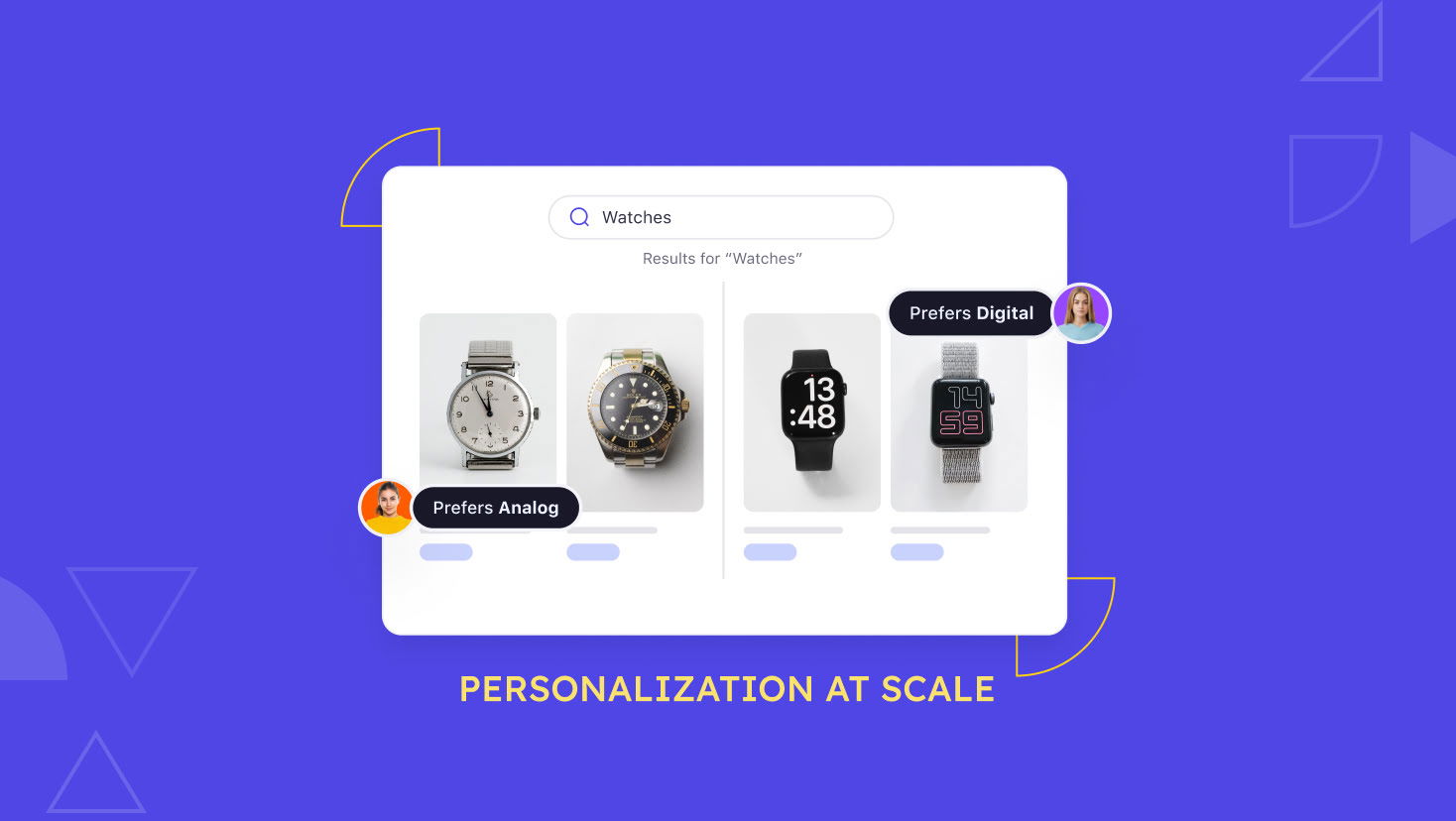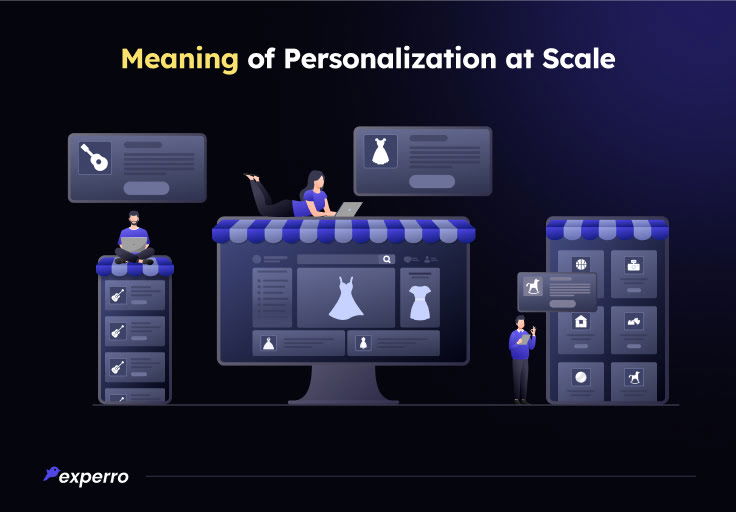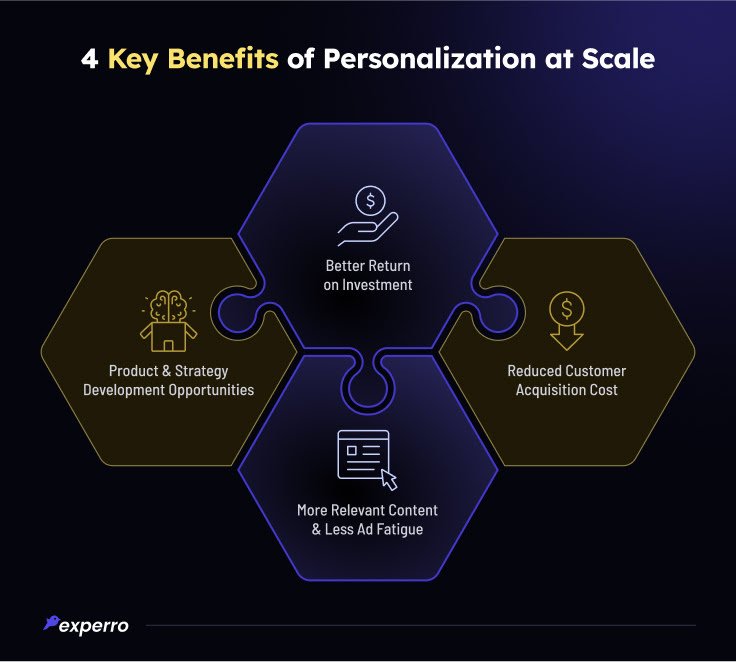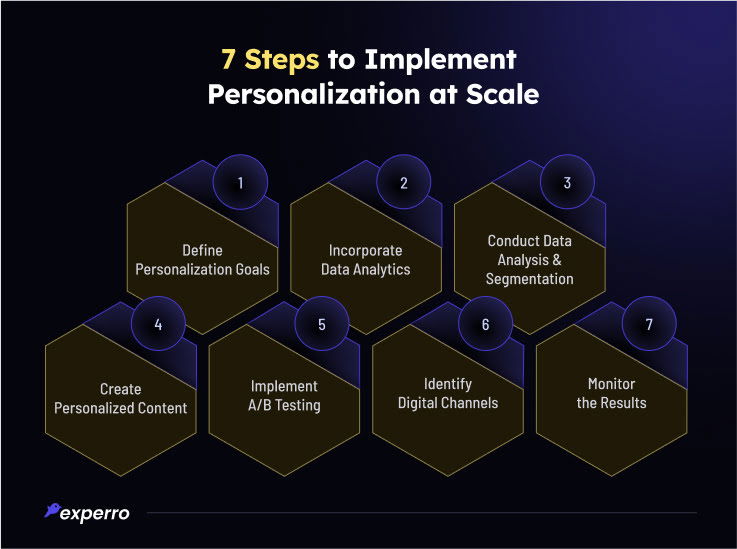Personalization at Scale: Pros, Challenges & AI-Driven Solutions

What’s Inside
- What is Personalization at Scale?
- What Are the Examples of Personalization at Scale?
- Statistics on Personalization & Customer Engagement Marketers Must Know
- What Are the Benefits That Personalization-at-Scale Unlocks?
- How Can Marketers Execute Personalization at Scale In 7 Steps?
- Personalize at Scale & See the Maximum Impact on Sales
- Challenges & Solutions of Personalization at Scale
- How AI Can Help with Personalization at Scale?
- Want to Create Hyper-Personalized Experiences for Customers & Increase ROI?
- Conclusion
Key Takeaways
- Personalization at scale helps to engage a large user base by tailoring content to customer's specific needs.
- Personalized content and recommendations increase conversion rates and help to drive more revenue.
- It increases overall customer experience and lifetime value.
- Experro is a DXP that enables businesses to create hyper-personalized experiences for customers.
It takes one click to get a conversion and, sadly one click for a user to jump to another website.
We cannot deny the fact that conversions are just a click away, but so is losing a user to another website. Today users prefer to stick to websites that provide them with the most relevant content.
What if you decide to buy a shoe and the shopkeeper keeps showing you Barbie dolls? That's funny, right? The same goes for online shopping.
Users stick to those websites that show them the products they are interested in.
If you have seen a piece of content that most resonates with your interest, that is personalization. And when it is done for a larger group of people, it is personalization at scale.
Personalization at scale (or customization at scale) is like a bridge that connects your brand with the larger audience. When we talk about scale, in marketing it means targeting a huge number of people.
Whether to personalize or not personalize is not a question anymore. Rather, how to personalize at scale for maximum ROI is the right question!
In this blog, we will talk about personalization at scale, its pros, and ways to achieve it. So, let's first understand its meaning.
What is Personalization at Scale?

Personalization at scale refers to analyzing large amounts of user data to deliver relevant customer experiences based on their interest, preferences, and purchase history.
The aim of personalization at scale is to deliver personalized experiences to a large amount of audience and increase ROI.
Delivering a truly personalized experience requires more than just emails with names. It's time to break through the traditional methods and embrace the new hyper personalization strategies.
What Are the Examples of Personalization at Scale?
Following are the popular personalization at scale examples:
1. Netflix
Netflix employs personalization algorithms to recommend movies and TV shows to its millions of subscribers. It considers factors like viewing history, genre preferences, and user ratings to create individualized content recommendations.
2. Spotify
Spotify offers personalized playlists like "Discover Weekly" and "Release Radar" based on users' music listening habits. These playlists are updated regularly to keep the music experience fresh and tailored to each user's taste.
3. YouTube
YouTube uses personalization to suggest videos to users based on their watch history and engagement. The platform's homepage and "Up Next" recommendations are personalized to keep users engaged.
Statistics on Personalization & Customer Engagement Marketers Must Know

Source – Exploding Topics
Read our detailed blog on eCommerce personalization stats to know more about the importance of personalization and industry insights.
What Are the Benefits That Personalization-at-Scale Unlocks?

Personalization at scale unlocks several advantages for businesses. Some of the key advantages are as follows:
1. Better ROI
Simply creating content and posting it without personalization is meaningless.
In fact, in the eCommerce industry, the cost of not personalizing is much higher than the cost of personalization efforts.
While scaling eCommerce personalization may involve resources and time, strategically crafting a personalized marketing campaign will reach thousands of customers. This will certainly make the investment worthwhile.
The ROI of personalization-at-scale is worth every effort. Over the years, marketers have seen an increase in ROI after personalized marketing campaigns. 89% of the marketers see a positive ROI with personalized offers.
This is how digital personalization at scale strategy increases ROI:
- Reduces customer acquisition cost
- Increases customer engagement
- Higher conversion rates
- Increases customer retention
- Reduces ad fatigue and customer churn rates
2. Reduced Customer Acquisition Cost
"The cost of acquiring a new customer is higher than retaining an existing one.''
If you are a digital marketer, you would know how difficult and costly it is to bring new customers.
On the other hand, retaining existing ones doesn't require the same planning and cost. If your existing customers are happy, they are certainly going to bring more customers.
Personalized messages, suggestions, and cross-selling & upselling help to engage customers and create a positive experience.
Additionally, personalized marketing spreads positive word of mouth. This increases brand loyalty and brings more customers on board.
Since the brand has its advocates (loyal customers), they don't need to spend money on acquiring new customers. Hence, the customer acquisition cost reduces.
3. More Relevant Content & Less Ad Fatigue
Did you know people who see an ad 6-10 times, 4.1% less likely to purchase compared to those who viewed the ad 2-5 times?
We all have seen irritating ads so often that we stopped engaging with those brands. That's called 'Ad fatigue'. Ad fatigue reduces the chances of conversions and also imposes a negative brand image.
But what if ads are personalized, just according to the interest of the target audience? This will increase the chances of click-through rates and conversions.
4. Product & Strategy Development Opportunities
To create personalized digital experiences businesses can collect consumer data such as user behavior, preferences, and purchase history. These digital experience analytics can be used to understand the audience better on a larger scale.
Through the right customer database, marketers can know which products are highly in demand and which are not. According to that, they can bring improvements in certain products, strategies, and content.
While personalization at scale brings many benefits, there have been instances where personalization has gone wrong for businesses due to a lack of proper understanding. So, let’s dive into the steps to execute it the right way.
How Can Marketers Execute Personalization at Scale In 7 Steps?

The steps to achieve mass personalization at scale are as follows:
1. Define Personalization Goals
The initial step is to establish a clear goal for personalization, which starts with a comprehensive understanding of your business objectives.
Marketers can have a wide range of goals to achieve with personalization efforts. The goals can include the following aspects:
- Increase repeat purchases
- Build brand awareness
- Greater customer retention
- Higher conversion rates
- More website traffic and pay-per-click
Suppose your brand is new to the market, the primary focus might be on raising awareness. In that case, a personalization at scale strategy will involve targeting new customers.
Conversely, for established brands, the goal may be boosting repeat purchases and increasing conversion rates.
2. Incorporate Data Analytics
Now that you are all set with the goal, the next step is to implement digital experience analytics. This will involve fetching valuable customer data such as their interest, preferences, purchase history, location, and so on.
These rich insights about customers will help marketers understand customer journeys and their needs on a deeper level. This will help them to deliver the most relevant results.
3. Conduct Data Analysis & Segmentation
You have all the customer data! That data is like a goldmine if you know how to leverage it effectively and make the most out of it!
With tons of customer databases, it is easy to get overwhelmed. But segmentation is so far the smartest way to utilize this data. You can segment your audience based on specific objectives.
How to do the analysis and create audience segments? Read the example below to learn how!
Suppose 400 individuals searching for 'white shoes' on your eCommerce website, derived from first-party data. It's essential to analyze —whether they click on search results, add items to their carts, or make purchases.
This analysis unveils user intent, allowing you to establish categories like 'potential buyers,' 'non-converters,' and 'frequent visitors.' This is how data analysis empowers you to segment users based on their shared characteristics.
4. Create Personalized Content
The data of customer segments is ready with you. The next step is to create personalized content to target those users. This digital content strategy will involve content tailored to specific segment groups.
For instance, it could involve developing specific content for that segment of potential converters for the white shoes category.
You can share emails for personalization at scale with them or prominently display white shoes in their browsing experience.
Whether they visit your website, app, or social media, it's crucial to share personalized marketing messages. Similarly, you can develop personalized content strategies for various segments.
5. Implement A/B Testing
It's time to identify the best version of your personalized marketing material. It can be a comparison for a webpage, social media post, or any other marketing asset. Start by formulating a hypothesis.
For example, you might hypothesize that users who see personalized recommendations for white shoes will have a higher conversion rate compared to those who do not receive such recommendations.
Show variation A to 50% of the audience and variation B to the other 50% of the audience. Their engagement on both landing pages will be tracked for you to identify which users like.
6. Identify Digital Channels
Your personalized content is out there on various digital channels such as websites, social media, and mobile apps. Now you need to identify which channel is the most effective.
Ask these questions:
- On which channel do customers interact the most?
- From where do they come on the landing page? (identify the source)
- Where are they likely to buy most items?
7. Monitor the Results
Monitor the effectiveness of personalized marketing efforts. Define clear KPIs (Key Performance Indicators) for each campaign.
These KPIs can be the following:
- Conversion rates
- Click-through rates
- Revenue per user
- Average order value
- Engagement metrics
Regularly evaluating these metrics allows you to make informed decisions and continually enhance the personalization experience for your audience.
Challenges & Solutions of Personalization at Scale
Following are the challenges and solutions of personalization at scale.
1. Changing Customer Expectations
Customer expectations are always changing with time.
First, you need to identify what has changed and why. This can be done with digital analytics. After identifying the change in behavior/pattern think about alternative solutions.
Track customer journey and do funnel analysis to identify where they left off. One reason for a change in customer needs could be a change in trends.
Solution – Keep up with the ongoing eCommerce personalization trends and provide tailormade results to customers with the help of AI functionality.
2. Managing Customer Data
Customers interact with brands through multiple channels. This data is large and involves tons of sensitive customer information such as their payment info, customer profiles, addresses, etc.
The data breach can hamper customer loyalty and brand reputation. So, managing this data effectively is crucial.
Solution - A power-pack headless CMS offers a centralized data repository to manage large customer data.
How AI Can Help with Personalization at Scale?
Generative AI for eCommerce is a significant element and personalization is no exception. At the same time, it is important to understand that personalization is not only limited to content and product recommendations.
The website's search functionality is equally important when it comes to driving conversions. If users don't get accurate results quickly, they will jump to other websites.
Experro offers AI-powered search to enhance the search experience of users. It gives personalized results based on the user's search query.
Let's suppose a user has purchased an oval-shaped ring in the past. Now whenever a user searches for rings, based on the history, it will show oval-shaped rings first.
Not only that but it also offers auto-correct and NLP (Natural Language Processing) features to enhance user experience.
Conclusion
Personalization at scale is a transformative approach to hook users on the website and drive more conversions.
Today, it goes beyond sharing emails with names and involves AI, A/B testing, leveraging omnichannel personalized experiences, and much more.
Without giving more thought, start personalizing at scale with Experro! Contact our team today to book a demo and understand how we can transform your eCommerce business.
Stay tuned for more such articles on personalization, eCommerce, and customer experience!
FAQs


Priya Zala
14 June 2024Through her writing, she has a lovely way of capturing users' pain points and delivering solution-oriented content. Her writing is sure to captivate readers and leave them with a lasting impression. When not crafting content, Priya enjoys getting lost in a good work of fiction, which soothes her soul.